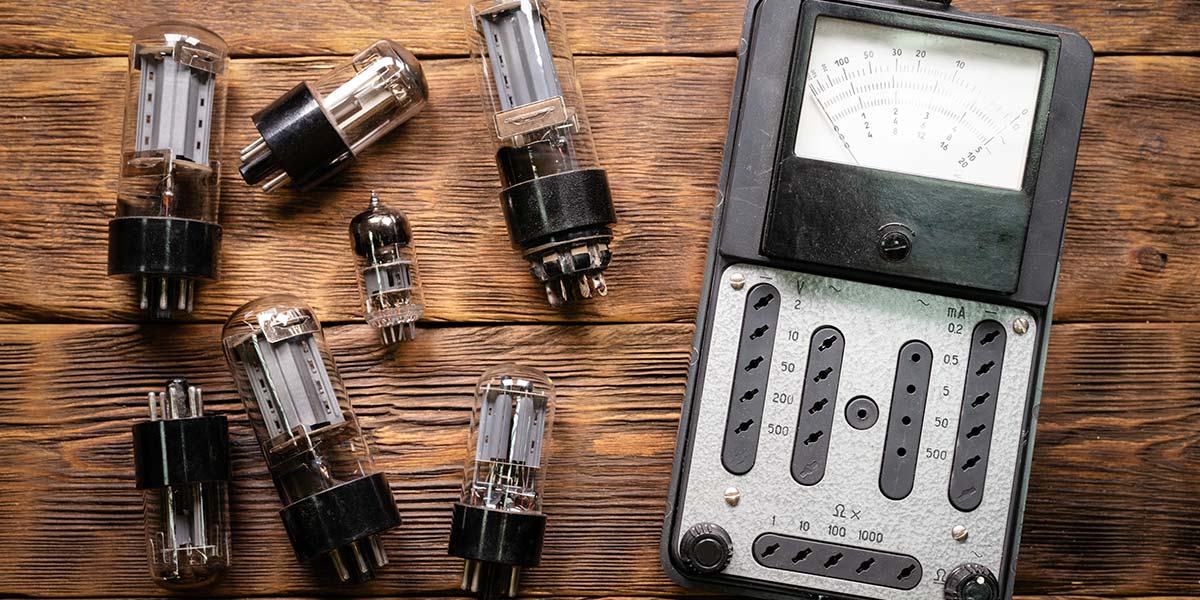After decades of focusing on microcontrollers, MEMS, and barely visible SMDs, I’ve returned — at least for the next year or two — to the danger zone of high voltages, high temperatures, and heavy metal.
Over the last few years, I’ve refurbished a DX-60B ham receiver from my childhood; three Zenith table-top radios from the 1950s; a McIntosh tuner, preamp, and amp; and a handful of analog instruments.
I haven’t given up my benchtop DMM, digital oscilloscope, or digital function generator. However, there’s something about aligning an old tube radio with a Simpson 311 vacuum tube voltmeter (VTVM) that can’t be beat.
My once mainly empty parts bins are now overstuffed with chunky 600V capacitors, 2W resistors, and, of course, vacuum tubes. One of the odd results of shifting to vintage tube gear from modern electronics is that there is no place for radial capacitors. Virtually every electrolytic capacitor that I’ve run across in vintage gear has axial leads, reflecting the reliance of point-to-point wiring instead of circuit boards.
My ESD mat now serves as a desk protector, scarred from my handling one sharped-edged heavy metal chassis after another. I’ve become hooked on contact cleaner — especially CRC QD and DeoxIT — for cleaning scratchy potentiometers and rotary contact switches.
Then, there are the hand tools. I’ve given up ruining my 4.5” CK antistatic diagonal cutters on 18 gauge component leads buried below layers of point-to-point wiring. Now I work with 6” channel lock pliers with extra long snouts that enable me to pluck a component from the bowels of a circuit without disrupting other components.
And my Weller WD station and pinpoint tips designed for SMD work just don’t cut it for heavy terminals and wires. I’ve moved to a simple 100 watt Weller 100P that’s capable of soldering to a bare chassis if I need to.
My Rolodex for go-to supplies has also evolved. While I still rely on the big parts houses — Mouser and Digi-Key — I save time by visiting curated collections of high voltage capacitors, wire, tubes, and switches from the likes of Antique Electronic Supply (tubesandmore.com), TubeDepot (tubedepot.com), Hayseed Hamfest (hayseedhamfest.com), Parts ConneXion (partsconnexion.com), and Sal’s Capacitor Corner (http://tuberadios.com/capacitors/).
Sal’s offers affordable kits of capacitor values most often found in vintage radios and test gear. Antique Electronic Supply offers just about everything you could need for a vintage radio repair, including schematics.
Hayseed Hamfest is my go-to for custom electrolytic can capacitors, and the Parts ConneXion caters to high-end audiophile hardware.
Perhaps the biggest retooling of all is my thought process — including my appreciation for safety. Most of the devices I work with are directly connected to the power mains, without an intervening transformer.
That means I never plug a piece of vintage gear directly into a power socket, but minimally use an isolation transformer to keep me and my test equipment safe.
With a non-polarized plug, the odds are 50-50 that the chassis is hot. And there is the issue of heat. The tubes and power resistors are easily hot enough to cause blistering burns.
Is retooling your shop and your mind to the world of vacuum tubes worth it? If you’re contemplating expanding your knowledge base or revisiting your past, should you invest in a new infrastructure or stay the course?
Well, there’s certainly more for anyone to learn about the ever-expanding world of microcontrollers, drones, and the like.
However, there’s just something magical surrounding a simple tube device, with maybe two to six active components that you pluck from an attic or eBay. NV

